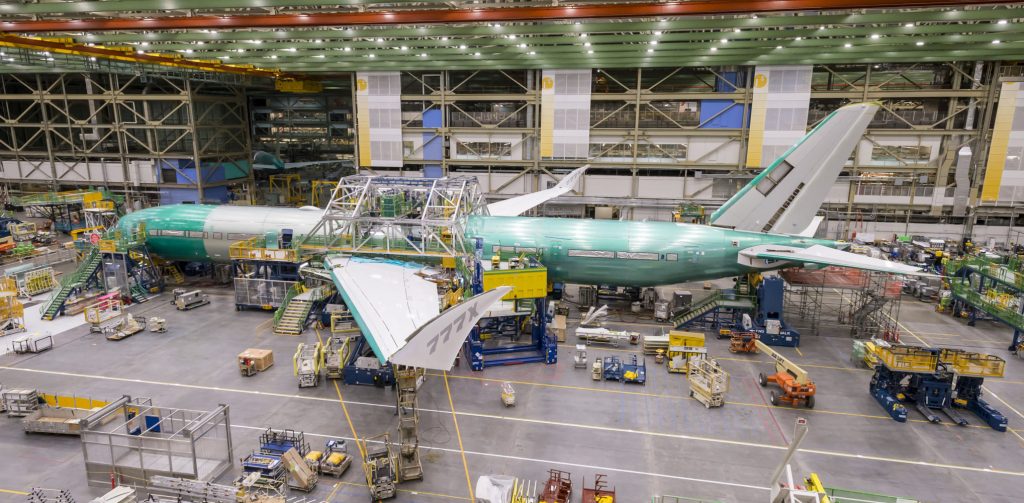The GE9X is General Electric’s latest and biggest ever engine and could be the power plant that brings to fruition Project Sunrise, the Qantas ambition to launch non-stop commercial flights between Sydney and London. Now undergoing ground and flight testing, the US engine-maker says all systems are go for entry into service in 2020.
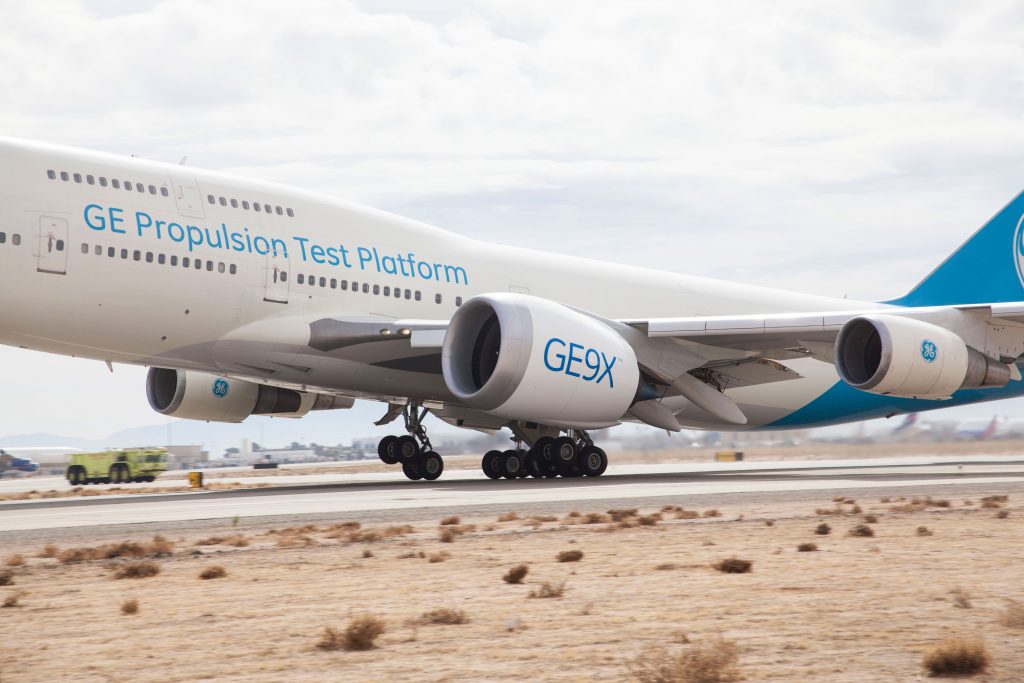
A key milestone was achieved at the Boeing Everett factory in Washington in November when engineers completed assembly of the major fuselage sections of the first flight-test B777X, the manufacturer’s latest long-haul, twin-aisle jet.
The final join mated the nose, mid and aft sections of the 77 metre (252 feet) long aircraft, the longest passenger jet Boeing has produced.
What the airframe lacks right now are the powerful engines that will ultimately lift it into the sky for the first time next year.
Those engines, said Ted Ingling, general manager for the General Electric GE9X engine program, are coming soon.
The biggest, most powerful and most fuel-efficient engine created by GE, the 9X has completed two critical phases in its development: static testing and initial flight testing mounted on a B747-400.
The final step is marriage of the engine to the new 777X airframe, planned for early this year.
“This 777X aircraft is going to deliver 20 per cent fuel economy over one of the best airplanes in the industry, the 777-300ER,” Ingling said.
“And the engine is half of that.”
He said that GE had taken an engine with “good performance characteristic” to “squeeze” out even better performance. The result is a quieter engine with “dramatically lower” greenhouse gas emissions.
“And you do that while not sacrificing reliability, or durability, or the availability of the engine to fulfill what the customer’s looking for: a means of transport for their business model.”
Ingling said the B777X also dovetails nicely with the Qantas goal of acquiring an aircraft that can fly non-stop from Sydney to London, or Melbourne to New York.
“The 777X-8 version is really tailor-made for this mission,” he told Australian Aviation during a podcast. “Boeing set it up to be in that environment.”
He said GE, meanwhile, had set up the engine to deliver the thrust and fuel economy capable of meeting Qantas requirements.
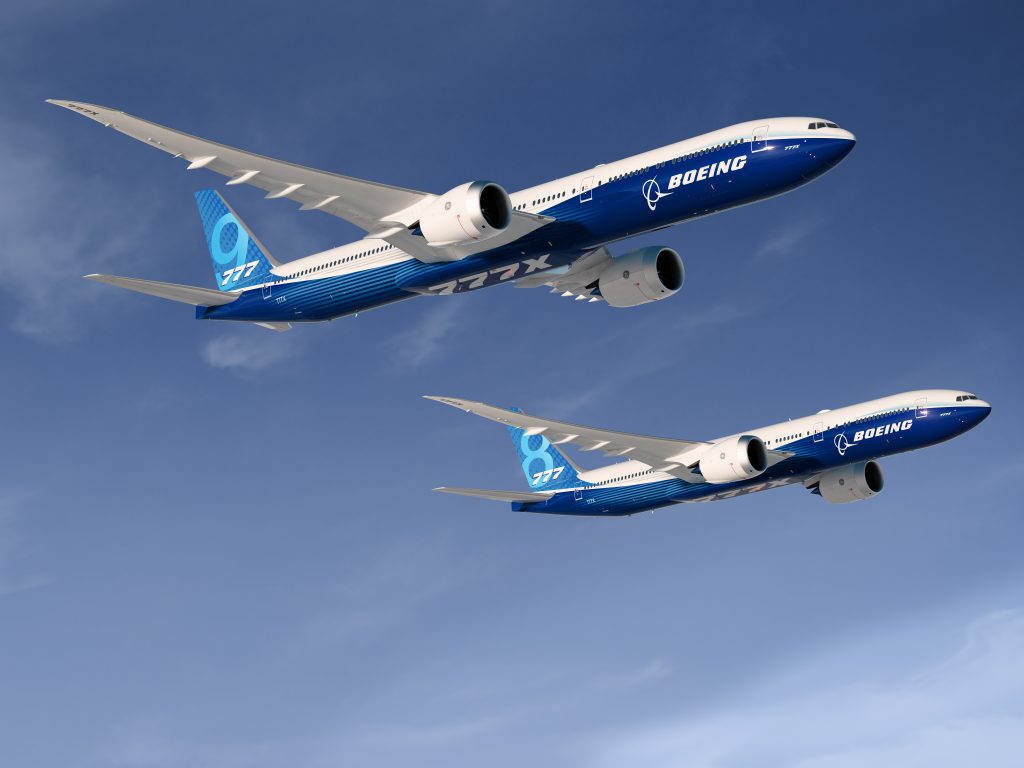
Ingling, who has been with GE for 37 years, said the foundation of the architectural philosophy and technology for the new engine began seven years ago.
“It started in the components where we had a vision for what we wanted the architecture to look like. We had a whole selection of technologies that we wanted to install in it. And we started building the component validation of those technologies.”
Ingling said the GE9X is a generational development of engine architecture with origins in the design, in the mid-1990s, of the original GE90 engine. In its iteration as the GE90-115B it went on to power the popular B777-300ER.
“The 9X is really 80 to 85 per cent architecturally similar to the fifth generation of that original GE90,” Ingling said. “We’ve infused technology to enhance the capability. This engine has the biggest fan diameter we’ve ever created – 134 inches in diameter (3.4 metres). If you want to do a kind of a calibration on that, the fuselage of a B737 is just a couple of inches bigger than that.
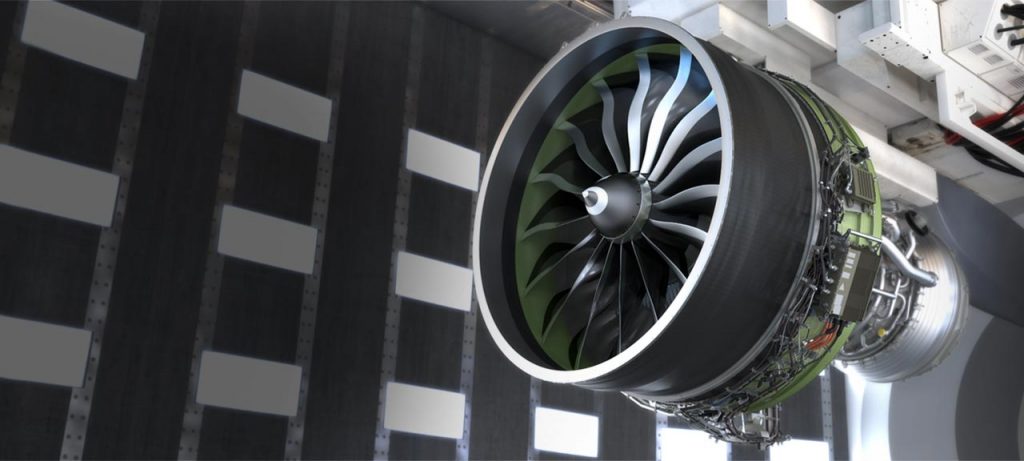
AVIATION
“The next time you’re sitting on a Boeing 737, and you’re sitting three against three with an aisle, you can think about the size of a GE9X engine.”
The bigger the fan, the bigger the propulsion efficiency, explained Ingling.
“Some 90 per cent of the thrust comes from that big fan. That allows us to get a lot of air moving slower, so it’s quieter; it’s much more efficient. “The core, which is the other 10per cent of the thrust, can be smaller, and so we use that philosophy to get efficiency and (lower) acoustic emissions.”
Ingling said that while propulsion efficiency increases with fan size, it does deliver challenges around weight and drag which can serve to erode the most effective fuel burn. “The whole equation is you want good efficiency, you want light weight, and you want low drag to get the most fuel efficiency,” he said.
Along with a bigger fan comes a better bypass ratio – “the amount of air that big fan moves around the core compared to the air flow that actually goes through the center of engine,” Ingling said.
“The GE9X is about an 11 bypass ratio and that compares to, say, a GENX, which was just a few years earlier, (of) around 10.2. And if you go back to older engines, they were in the five class… We’ve doubled the bypass ratio.”
Also key to producing a better engine is the use of ceramics. Ingling said the GE9X uses “ceramic matrix composites” in the high pressure turbine end of the engine, capable of sustaining temperatures “about 500 degrees” greater than the nickel-based alloy in the turbine airfoils.
“It’s an opportunity for us to not only make the turbine lightweight, because these things are very light, but also raise the capability of those components to survive in an environment that is extremely hot.”
He said that in a conventional engine, compressor air is used to cool the nickle-based alloy turbine airfoils. “We film-cool those to make sure that the airfoils can actually survive. Without the cooling, the temperature of the gas is hotter than the metal alloys can withstand. When we use that air to cool those airfoils it’s inefficient. We like to use as little air as possible, and ceramic matrix allows us to dial back the amount of air because the material is so much more capable.”
Another critical element in the design has been development of the fan blades which are shaped differently from earlier models. “It’s absolutely about the aerodynamic technologies that we’ve learned from the computer models,” he said.
The shape of the airfoil is designed to address the velocity of the air emtering the inlet.
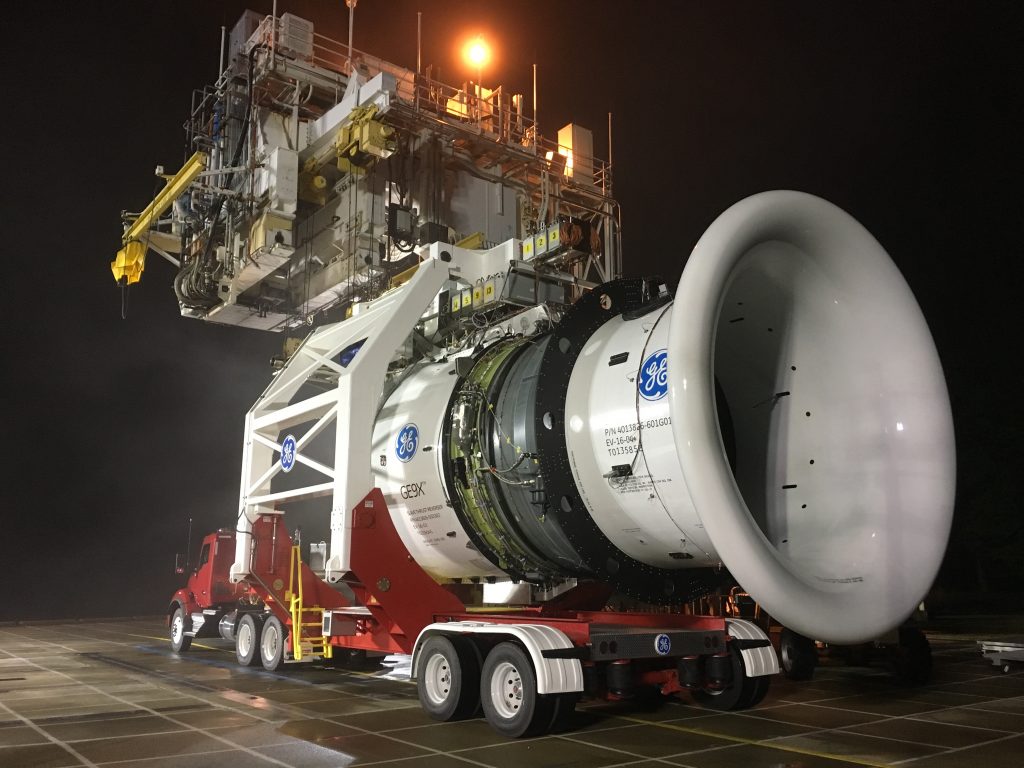
“The older blade design was straight-edged. You can actually tell an older design when you look into the engine by how straight and radial those leading edges of those fan blades are.”
Ingling said the new shape marries the flow of air through the inlet, to the fan blade, and “drops the losses”.
The composite blade material is a fifth-generation composite fibre. “The blade started off on the original GE90. I was one of the original design members of the team that brought that first composite fan blade in to service on the GE90. We call it the 94B. It’s extremely lightweight, extremely strong material that is suited exactly for composite fans, for fan blades. It’s a tailor-made.
“What we learned over the years however, is (that) as we shape the airfoils to match up with airflow, we need fewer of them. So we went from 22 blades on the original GE90 down to 18, and now we’re at 16.
“We get all the flow and thrust out of these blades, and we do it with more efficiency because of all the aerodynamic knowledge we’ve gained over the years.”
Getting the engine from initial planning and design through to construction and testing has been a complex process.
“We started (powered up the engine) in March of 2016. We took that first engine, which is intended to validate the architecture, all the design decisions we made, to make sure that we understood what and how those parts worked together,” explained Ingling.
“It was really the first time that we brought the compressor to the turbine, the low-pressure turbine to the high pressure turbine. All of that stuff gets married up and running that first engine.
“About 13 months later, we ran the very first production version that was going to be in our developmental certification. And we purposely spaced out that time, that 12 to 13 months, because our history has told us that the first engine tells you something needs to be fixed, right?
“So we built the programme with some extra time built into in cto try and take the opportunity to really look hard at that engine, make sure everything’s working right, before we jumped in the middle of certification.”
There are now eight engines in the certification. “All eight of them are on the stands at one point or another. We’re about halfway through the engine certification effort, and things are going well. We’re clicking off all the tests. We’re busy, there’s no doubt about it, but things are clicking off very well.”
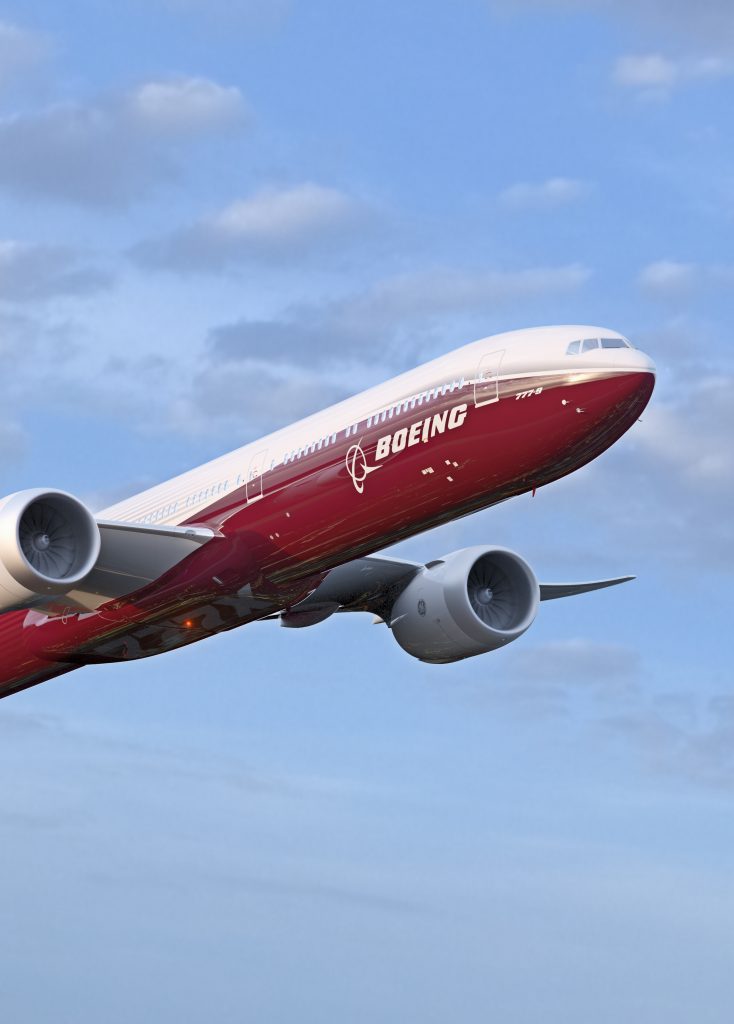
The engine is now operating on a flying testbed, a B747-400.
“The engine is in the number two position,” Imngling said. There’s no mistaking it. It sits above the wing at the very front and they’ve had to do some gymnastics to get that engine to sit underneath that wing.
“When it’s on the ground, it’s got about 18 inches (45 cms) of ground clearance. It’s pretty tight… “
GE has eight engines in production and each will go to Boeing for the the flight test programme. “They have the new aircraft coming off the assembly line. They’ll marry it up to these new production engines, and they’ll start their flight test programme using those engines. The first one is in Cincinnati running through the testing right now.”
It has been an emotional process for Ingling: “There’s three magical moments, and we’ve passed two of them,” he said.
“The first engine that goes to test, and you hear that engine fire up the first time, and you run it through its phases, that’s a really surreal kind of moment. You see all the efforts that go into each part being designed, and produced, and manufactured, and assembled, and it’s really the fruits of your labour there.
“The second one is when that engine powers an aircraft to go up in the air, and that was on the 747. So, about this time last year, we are flying our 747 for the first time, and that’s a special moment, to see that engine take off, and power the aircraft, or help power that aircraft to go.
“The third one is when the real aircraft with your real engine goes out and starts its first flight. So, those are really exciting times. There’s a lot of busy work in between all those.”
Interestingly, while new technology and analytics has brought incredible change to the business of designing and producing a new generation engine, Ingling said GE hasn’t lost sight of its roots.
“I’d say it’s (technology advance) certainly an element. It changes the way we design the product. We certainly spend a lot more time in the analytical space. But we haven’t lost our roots in running component test. We have a philosophy of building a new technology through its components, to sub-assemblies, to modules, to full engines. So, we’ve anchored ourselves with that history.
“But I’ll tell you we spend a lot more time on the computer systems and relying on the computer modules. I guess the other big changes, as with any industry, is the materials that we use. The materials have enabled the architecture of the engines to change dramatically, from the days that I first started working to what we’re building today. It’s a dramatic transformation … of engine shapes, design, and architecture.”
Ingling said that although there have been things that needed fixing through the engine development phase, there have not been major issues.
The decision to allow plenty of time for development was absolutely the right decision, he said.
“It helped us mature the product, and… we built all eight engines to the same standard. Instead of having ‘engine two’ six months after engine one, and finding something in ‘engine one’, but engine two is built, we now have all the engines with all the right fixes in them.
“It’s absolutely the right way to do it, and you have to plan for it. You have to anticipate that’s something you want to do, and then you’ve got to react to the findings you get when you run that first engine.
“But even the first engine was a huge success.”
He accepted there were various components that needed amendment: “We said, ‘hey, this is something that we need to fix, it’s appropriate to fix’ and so we took the time in that time window to change the standard.”
GE Aviation has developed a new testing philosophy and process specifically for the GE9X. The company expects that by applying its new ideas to the engine certification testing program, the powerplant —designed as the sole-source engine for the 777X family —will enter service offering reliability and durability as least as good as the mature GE90-115B powering the 777-300ER.
By the time the GE9X enters service, GE Aviation expects to have conducted about 18,000 flight-equivalent cycles. It is also confident that maintenance of the engine for its airline customers will also be extremely efficient.
“We’re trying to get more and more to predictive maintenance. The worst thing for an operator is the unscheduled event. You get a warning, you’ve got a whole host of people on the aircraft, and then you get a signal that the engine is not ready to perform,” Ingling said.
“And so we’re trying to become more predictable, and in doing that we’re really leaning into the digital space and analytics.
“It’s a journey and this is the first engine that has been designed with the digital space in mind, meaning we have the manufacturing records that come from the beginning on how the parts perform. We call them key characteristics. And we have the digital models, data process and data flow. And so, it absolutely is the first engine that we would declare as digital first.
The GE9X will also be fitted to another varient of the B777X – the 777X-9 – which Ingling described as “a little bigger that the standard B777-300ER” and with similar range.
“They carry a common engine. That’s not always the case when you have a variant on an aircraft – that the engines are identical. But in this case the engines are interchangeable and identical between a 777X-8, or a -9 aircraft.”
That said, he recommended the 777X-8 as the appropriate aircraft for the Qantas project. “It’s the one to do that mission from Sydney to London.”
Qantas is yet to make any decisions around the type best suited to its ambitions. Other contenders include Boeing’s competitor Airbus with its A350 ULR (ultra-long range).
